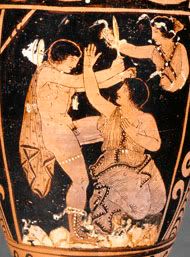First, there is a slideshow with audio commentary which displays seventeen of the art pieces displayed. Check out the slideshow.
Second, they put up a reading of a fragment of a Sopholces satyr play called the trackers. As far as I can tell, the pronunciation is pretty good. However, my pronunciation and linguistic understanding is still not what it should be. If anyone has any thoughts, I would love to hear him. The audio can be found here.
Although I did not get to peruse them very thoroughly, there are three books that the Getty published in conjunction with exhibit. Two of them, The Pronomos Vase and It's Context
Sadly, the books are all extraordinarily expensive. This, however, is not unexpected given the price of classics books in general. In a thesis meeting, I was told by Messalla, my fabulous thesis adviser, that classics textbooks were originally significantly cheaper (with adjustment for inflation). Publishers eventually realized that a large portion of the audience for these books was comprised of professors and libraries, most of whom had access to some portion of the University budget. As such, the publishers realized that they could increase their profit margin by making the books ridiculously expensive-- thereby cutting out the student and causal-reader market-- and sell the books significantly more expensively from smaller printings (which were more expensive per book to make). I do not have any specifics on the Getty as a publisher, but think that, in general, the expense trend with classics books is ridiculous. Although libraries are a great resource, with public funding decreasing everywhere, a lot of libraries are having trouble affording the same books that students cannot afford for themselves. Also, the rarer and more expensive the books are, the more likely they are to be stolen (a bunch of expensive classics books were stolen from my college last year) and then resold.
I do not believe there is any real way to break the trend of such expensive books. Some publishing houses obviously provide significantly better prices than others. And, of course, I would never want to deny money or publishing access to the scholars who produce the wonderful things that I read. I know this might sound a little hypocritical given my recent blogpost, but would it not be better if publishing houses just made books less expensive, rather than making them really expensive and then putting some portion of the scholarly collection up for free online (see the incredible CDL archive). I love ebooks and free books, but I would not search for them quite so hard if the books I needed were less expensive or appeared in more libraries.
I do not believe there is any real way to break the trend of such expensive books. Some publishing houses obviously provide significantly better prices than others. And, of course, I would never want to deny money or publishing access to the scholars who produce the wonderful things that I read. I know this might sound a little hypocritical given my recent blogpost, but would it not be better if publishing houses just made books less expensive, rather than making them really expensive and then putting some portion of the scholarly collection up for free online (see the incredible CDL archive). I love ebooks and free books, but I would not search for them quite so hard if the books I needed were less expensive or appeared in more libraries.















